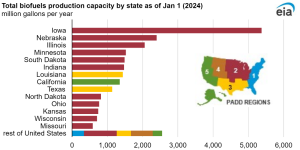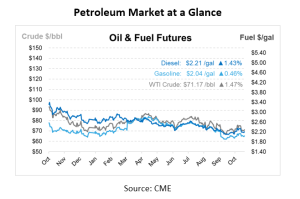
Crude Climbs Back Above $70 as Biofuel Capacity Soars
U.S. crude oil prices climbed back above $70/bbl on Monday, with crude and refined product contracts ending the day with gains. December WTI crude rose by $1.35 to settle at $70.04/bbl, while Brent crude gained $1.23 to close at $74.29/bbl. The gains followed sharp declines from the previous week, where U.S. crude contracts dropped by over 8%, gasoline by 7%, and diesel by 8.2%.
Price rebounds were largely fueled by global geopolitical tensions, particularly escalating violence in the Middle East. The ongoing conflict between Israel and Iran has injected a risk premium into oil prices, as the market braces for potential supply disruptions. China’s increased crude oil import quotas, alongside a 25 basis point interest rate cut by the country’s central bank to stimulate economic growth, provided further pressure for rising prices.
Volatility remains a key factor, with markets responding to shifting dynamics in both crude and refined products. The U.S. court’s decision to delay a legal dispute over Gulf of Mexico drilling regulations has also added complexity, further contributing to oil supply and pricing uncertainty.
While crude oil markets fluctuate, U.S. biofuel production has quietly made strides. In 2023, biofuel production capacity in the United States grew by 7%, reaching 24 billion gallons per year as of January 2024. This growth was led by a remarkable 44% rise in renewable diesel and other biofuels, such as renewable heating oil, jet fuel (also known as sustainable aviation fuel), and renewable naphtha and gasoline. These alternative fuels are becoming an increasingly important piece of the energy puzzle, offering additional supply options to the market.
Fuel ethanol remains the dominant biofuel, accounting for most of the U.S.’s biofuel capacity, which grew by 2% in 2023 to reach 18 billion gallons per year. Renewable diesel capacity also saw a notable increase, now totaling 4.3 billion gallons annually. Biodiesel capacity remained stable at 2.1 billion gallons per year.
Biofuel production is highly concentrated in Iowa, with the state representing over 5.4 billion gallons per year. Fourteen states account for 90% of the country’s biofuel production capacity, with recent expansions in Alabama, California, and Louisiana, where Louisiana and California alone represent over 80% of U.S. renewable diesel production capacity.

To complement these shifts in production, the U.S. has seen several new pipeline projects come online. Since 2023, four new petroleum liquids pipeline projects have been completed—three focused on crude oil and one dedicated to hydrocarbon gas liquids (HGL). The pipeline projects include the South Bend (150,000 bpd) from North Dakota to Montana, Keystone Port Neches Link (630,000 bpd) in Texas, Borger Express (90,000 bpd) from Oklahoma to Texas, and the Seminole Red Pipeline, which was converted from a crude oil pipeline to an HGL pipeline. These pipelines are part of a larger effort to boost energy infrastructure.

This article is part of Daily Market News & Insights
Tagged:
MARKET CONDITION REPORT - DISCLAIMER
The information contained herein is derived from sources believed to be reliable; however, this information is not guaranteed as to its accuracy or completeness. Furthermore, no responsibility is assumed for use of this material and no express or implied warranties or guarantees are made. This material and any view or comment expressed herein are provided for informational purposes only and should not be construed in any way as an inducement or recommendation to buy or sell products, commodity futures or options contracts.





